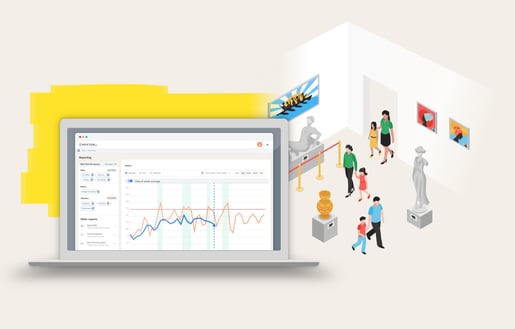Tate Modern is one of the most visited museums and galleries in the world. Since opening in May 2000, the gallery has welcomed over 40 million visitors. Access to Tate Modern is largely free with some paid special exhibitions being run throughout the year.

The Challenges Of Timed Entry Ticketing
To ensure a great experience for visitors to their paid special exhibitions, Tate Modern used a timed entry ticketing model, which meant that they limited the number of tickets sold at each time slot. The two key assumptions driving the number of tickets made available were:
- The length of the time slot and therefore the assumed amount of time taken to view the exhibit.
- The number of people allowed in the space at a given time, both in terms of capacity and for a positive visitor experience.
Assessing whether this was the right strategy for their exhibitions was a challenge for David Hingley, Head of Visitor Experience as he only had the data points of ticket sales and member bookings available. The data didn’t account for no-shows and the ticketing strategy assumed that visitors took the same amount of time going through the exhibition. Observationally, David found that some visitors moved through the space quickly and busyness differed through the day. This meant that there was potentially space to admit more visitors however aside from gut feelings there was no way to measure this.
The HoxtonAi dashboard shows us how visitors access our exhibition space and how this changes over the course of a day, a week, and through different seasons."
To plan a more effective ticketing strategy, they first needed to know if and when there was room to let more people in whilst maintaining a positive visitor experience. This required understanding the occupancy of the space at different times of the day and week.

Capturing Occupancy
David chose to trial the HoxtonAi occupancy solution for the Rodin Exhibition. Sensors were installed at the entrance and the exit in order to understand how busy the exhibition was overall. They also installed additional sensors within each of the four rooms within the exhibition in order to get more granular data.
Optimising Admissions To The Rodin Exhibition
Since the HoxtonAi occupancy solution provides both live and historical data, once the sensors were up and running David was able to see the exhibition’s live occupancy on their dashboard. He found that even during sold out periods, there was still space to allow more visitors in. As earlier assumed some visitors made their way around the exhibition quickly, freeing up space as they exited.
The accuracy of the solution allows us to confidently admit more visitors as space becomes available - something we’ve never been able to do in such detail before."
Over time, occupancy trends were spotted, allowing for more tickets to be released or more frequent timing of slots made available. In the simplest sense, whilst the gallery may have been sold out between 2pm and 3pm on a Saturday, the occupancy rarely exceeded 80%. Further, the occupancy data revealed different characteristics for each day of the week, thereby opening opportunities to tailor offerings to the occupancy observed.
...we can see the benefits of sharing this data with other departments."
In time, David plans to match peaks with troughs and smooth out demand, ensuring as many members and non-members can come and see the incredible art on show at Tate Modern.
Recent Articles
How real-time footfall data helped a Telco Franchisee drive a 20% increase in revenue
Duncan Mann | Oct 2024
Background: the importance of sales conversion rate
Read moreCase Study: How fashion retailer GOOD uses the HoxtonAi Retail Report to improve accountability and increase conversion across their stores.
Owen | Jun 2023
“The retail report has been a game-changer. Each week, we discuss the footfall and conversion ...
Read moreOn the accuracy of retail footfall counters
Owen | May 2023
In retail, footfall-related metrics have become cornerstone data points used to track various ...
Read moreThe OKR goal setting framework: how to drive success in retail
Owen | Apr 2023
At HoxtonAi, we speak to hundreds of retailers about their store management, data requirements and ...
Read moreHow combining different types of footfall data can build a digital view of physical stores
Owen | Apr 2023
One of the biggest differences between optimization in online and physical retail spaces is the ...
Read moreWhy footfall isn't the end-all. What to do about the retail data gap.
Owen | Apr 2023
In our experience, we’ve found that most retailers are familiar with the idea of monitoring ...
Read moreThe Main Challenges for Retailers in Fully Leveraging Footfall Data
Owen | Mar 2023
In today's digital age, data has become a valuable asset for businesses looking to optimize their ...
Read moreWhat We Talk About When We Talk About Retail Footfall
Owen | Mar 2023
The soft side of cold, hard data We’ve released content on the ‘hard’ aspects of using data to ...
Read moreTop 6 Essential KPIs & Metrics in Retail
Owen | Mar 2023
As retail technology has evolved, we have found better ways to measure, track and compare ...
Read moreWhat is Conversion in Retail? And How to Measure it in a Physical Store?
Owen | Mar 2023
What is a conversion rate? A conversion rate is typically considered to be the percentage of people ...
Read moreHow to use Footfall Analytics to Improve Store Performance
Duncan Mann | Mar 2023
Before we get started, for a quick reminder of what 'people count' and 'footfall' mean, check out ...
Read moreWhat We've Found Analysing Footfall Data in Retail
Duncan Mann | Mar 2023
5 Trends We've Noticed... "At HoxtonAi, we work with customers to ensure their data is high ...
Read moreClosing the data gap between online and physical retailing
Owen | Mar 2023
As shoppers continue to return to the high street post-pandemic, physical stores need to catch up ...
Read moreAn Introduction to People Counting in Retail
Owen | Mar 2023
What is people counting? Simply put, people counting is the act of counting the number of people ...
Read moreCase Study: How Center Parcs Use Occupancy Data To Drive Better Guest Experiences.
Duncan Mann | Aug 2022
We initially trialled the HoxtonAi solution on a small scale to ‘kick the tyres’ and see if it’s a ...
Read more